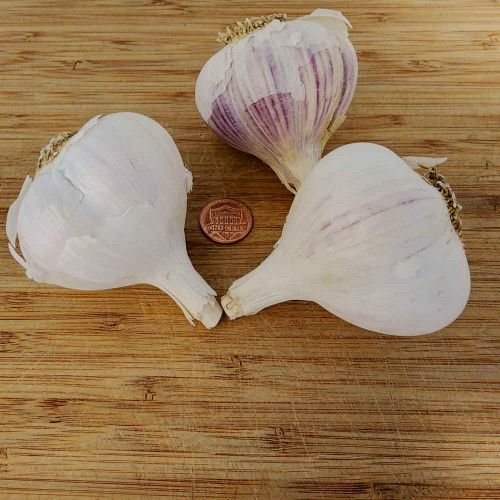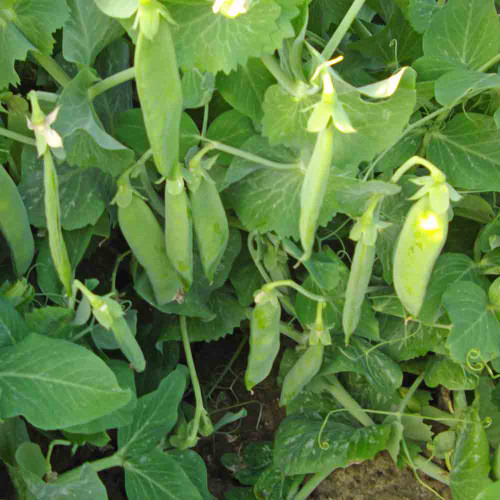Description
Persian Star Garlic – The Only Star You Need in Your Garden
Persian Star is a Purple Stripe type of hardneck garlic, a group prized for its beautifully colored wrappers and complex, nuanced flavors. It produces medium-to-large bulbs that typically contain 8 to 12 cloves arranged in a single, elegant layer around the central stalk. While the outer wrappers are a bright, clean white, peeling them away reveals the true beauty of this variety: clove wrappers vividly blushed with deep purple and tipped in silver-white. The name 'Persian Star' comes from the star-like pattern these pointed cloves create when the bulb is viewed from above.
The flavor is as remarkable as its appearance. When raw, Persian Star offers a pleasant, medium-level spiciness with a rich, nutty finish that is assertive but not overwhelming. Cooking tames this initial heat and unlocks a profound, buttery sweetness, making it a frequent "taste test winner" and a favorite of chefs for roasting. When crushed, the cloves release a pungent, earthy, and classically "garlicky" fragrance with subtle, spicy undertones.
History
To understand Persian Star is to understand the history of garlic itself. Its story begins in the mountainous terrain of Central Asia—the region encompassing modern-day Uzbekistan—which is firmly established as garlic's center of origin and the only place on Earth where its wild ancestor, Allium longicuspis, can still be found. For millennia, garlic was a cornerstone of the great cultures that flourished here, valued not only as a culinary staple but for its potent medicinal properties. This reverence is still visible today in Persian culture, they place garlic, known as seer, on the celebration table during Nowruz, the Persian New Year, representing health and vitality.
The genetic importance of the Purple Stripe group, to which Persian Star belongs, is central to its story. As the ancestral line of cultivated garlic, these varieties represent a living bridge to the very dawn of its domestication. This ancient heritage is the source of their remarkable hardiness and adaptability, traits honed over millennia of survival and selection in the harsh, variable climates of Central Asia.
The journey of this specific variety to American gardens is a chapter in the larger tale of the "Garlic Revolution." At the center of this story is our friend and mentor, John Swenson, a dedicated collector who traveled behind the Iron Curtain in 1989 on a USDA expedition. He was not a typical botanist; he was a successful lawyer whose "relentless pursuit of truth and accuracy" defined his professional life and fueled his personal passions. His fascination with the Allium genus led him to become a pivotal figure in the American heirloom seed movement.
In a bazaar in the ancient Silk Road city of Samarkand, Uzbekistan, he discovered this unique Purple Stripe garlic. His work in cultivating and generously sharing these treasures helped transform the diversity of garlic available to gardeners today. Offering Persian Star is our way of honoring his legacy and continuing his important work of connecting gardeners with the world's incredible diversity. Read John’s five tips on growing garlic in this interview.
About Hardneck Garlic
Persian Star is a "hardneck" type of garlic, a distinction that is key to understanding its growth, flavor, and culinary potential. The "neck" refers to the stiff, woody central stalk that extends from the bulb - a stalk that will become the delicious bonus harvest of young "garlic scapes" in the spring.
Garlic is broadly divided into two main categories, and while the softneck varieties are what you typically find in supermarkets, chefs and growers prize hardneck garlics for their remarkably complex and robust flavors. They are often described as richer and spicier, with a more pronounced "garlicky" essence. This intensity varies across different hardneck groups, from the mild sweetness of Purple Stripes, like Persian Star, to the fiery heat of Rocamboles and the deep, musky character of Porcelains.
While hardnecks are famously cold-hardy and thrive in northern climates, it is a common misunderstanding that they cannot be grown in warmer southern regions. The secret to success in these zones is a process called vernalization. If your area does not experience a regular winter freeze, you can simulate this necessary cold period by refrigerating your seed garlic for at least 40-50 days prior to planting. This procedure triggers the bulb formation process, allowing you to grow this exceptional northern garlic even in a southern garden.
Uses
Persian Star's greatest strength is its delightful balance of flavor, making it a superb all-purpose garlic. When raw, it has a surprisingly mild and sweet taste with a pleasant, mellow heat, perfect for dishes where you want a refined garlic flavor without an aggressive bite. This makes it an excellent choice for fresh pestos, salsas, and vinaigrettes. When cooked, its flavor deepens into a rich, nutty sweetness that is never overpowering. This quality makes it one of the best garlics for roasting whole, as the cloves become creamy, sweet, and spreadable. The tender scapes, with their mild garlic essence, are a versatile treat in their own right, perfect for grilling, sautéing, or adding to stir-fries.
Companion Planting
You will find that Persian Star garlic is a beneficial neighbor to a wide range of garden plants. It is particularly well-suited for planting alongside members of the brassica family, such as broccoli and kale, as its strong aroma is known to deter common pests like cabbage moths. It also grows well near tomatoes and peppers.
You should avoid planting garlic where other members of the allium family (onions, leeks) have recently grown to prevent the buildup of soil-borne diseases. It is also best to keep it away from asparagus, peas, and beans, as garlic can inhibit their growth.
Planting and Growing Tips
As a hardneck variety, Persian Star requires a period of cold exposure (vernalization) to stimulate proper bulb development. Gardeners in Zones 3-7 should plant cloves in the fall, about 4 to 6 weeks before the ground freezes. In warmer climates (Zones 8-10), this is best achieved by pre-chilling the cloves in a refrigerator for 8 to 12 weeks before planting in the coolest part of fall.
Break the bulbs into individual cloves just before planting, keeping the papery wrappers intact. Plant the cloves pointed-end up, about 2-3 inches deep and 6 inches apart, in a site with full sun and loose, well-drained soil rich in organic matter. After planting, apply a thick 4- to 6-inch layer of mulch, such as straw or shredded leaves. The mulch insulates the soil, conserves moisture, and provides excellent weed suppression. In early summer, remove the scape once it has formed a distinct curl to direct the plant's energy into bulb formation.
Harvest Tips
Persian Star offers two distinct harvests from a single planting. In late spring or early summer, your garlic plants will send up a flowering stalk known as a "scape." You should snap or cut this scape off once it has formed a loop to encourage the plant to direct all its energy into bulb formation. These tender scapes are a delicacy, with a mild, fresh garlic flavor.
Your main harvest of the bulbs will be ready in mid-to-late summer, when the lower leaves of the plant begin to turn yellow and fall over. Carefully lift the bulbs from the soil with a garden fork. To cure them for long-term storage, bundle the plants in small bunches and hang them in a warm, dry, and well-ventilated area for several weeks before trimming the roots and stems.
Learn More
Shipping Restrictions
U.S. shipping only, Cannot ship to certain counties in Washington or Idaho
From the soil to the seed to the food you eat - we'll help you grow your best garden!
1 Review
-
Fantastic flavor!
I love, love, love this variety! I tried it for the first time last year. Out of the six varieties that I grew it was one of the best. I intend to grow it every year from now on. I garden in 9b desert conditions.





















